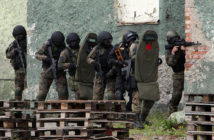Eurasia Review

Smoke over Westgate shopping mall on 23 September 2013. Photo by Anne Knight, Wikipedia Commons
SMOKE OVER NAIROBI, KENYA WESTGATE SHOPPING MALL ON 23 SEPTEMBER 2013. PHOTO BY ANNE KNIGHT, WIKIPEDIA COMMONS
By RSIS
East Africa – incorporating Kenya, Tanzania, and Uganda – is increasingly vulnerable to Islamist militancy due to severe internal structural problems that have led to rising inter-communal tensions, riots, and secessionist tendencies among their coastal populations.
By Ahmed Salah Hashim
THE RECENT terrorist attack on the Westgate Mall in Nairobi by Al-Shabaab, a Somali-based militant group linked to Al Qaeda, has highlighted Kenya’s target-rich environment for terrorists. Kenya has the most stable and democratic government in East Africa but has experienced the most terrorist attacks because of its relatively advanced economy and it has many soft targets like Westgate Mall.
Al Shabaab’s attack on the mall was allegedly undertaken with the help of local disgruntled Somalis and Kenyan Muslims. Kenya’slong-standing political and security ties with the United Kingdom, United States, and Israel have earned it the wrath of Islamist militants who are inspired by Al Qaeda’s determination to wage war against these ‘enemies’ of Islam.
Kenya: heavy-handed security and disaffected minority
Kenya has weak security forces whose heavy-handedness merely fuels the rage of locals targeted by security personnel. Then there is a disaffected minority Muslim population which is made up ethnically of Arab-Persians (known as Shirazis) Arab-Swahilis (Arab-African mix) and Somalis in the urban centres but especially along the coast. Muslims make up 13% of the population of Kenya but are the dominant religious group along the coast.
Many residents of the ports of Mombasa, Malindi and Lamu have stronger ties with the Arabian Peninsula and Persian Gulf than with Kenya’s own interior. Al Qaeda operatives have been able to employ a mixture of “mosque, madrasah, marriage, money” to establish roots along the coast of East Africa. While the vast majority of the coastal population are hostile to Al Qaeda and its agenda, the political and socioeconomic climate allows radicalism and militancy to thrive.
The Muslim community went from being privileged under colonialism to being subjects of an alien, up-country, and non-Muslim black political elite after independence. The loss of status was deepened by their aversion to Christian-dominated education, so that Muslims became, in local lore, “the first to read (that is, the Quran), but the last to go to school.”
Muslims were placed at a distinct disadvantage in the competition for formal employment in both the public and private sectors.The coastal population complain that most of the jobs in the thriving economy – in the ports, public sector, commerce and tourism – go to the people from the interior – the non-Arab African population – who the coastal population perceive as less civilised.
The problems in Mombasa, Kenya’s main port, are a reflection of the growing divide. In Mombasa’s poor Kisauni and Majengo neighbourhoods unemployment is at an all-time high and drug addiction is rampant. Many of the youths are ideal targets for political militancy. In August 2012 riots erupted over the murder of a popular local cleric, Abboud Rogo Mohamed, who was shot in his car by unknown assailants. Rogo’s supporters fought street battles with the security forces in the hours after his death, and sporadic violence continued over the following days with churches becoming targets. An outlawed coastal group, the Mombasa Republican Council (MRC), wants to secede from Kenya.
Rising Islamist militancy in Uganda, Tanzania and Zanzibar
Uganda has suffered less from either local or transnational militant Islamist groups. Al-Shabaab launched an attack in Kampala in 2010 in retaliation for the country’s decision to send troops to stabilise the situation in Somalia. More recently, in August 2013 the authorities arrested 25 suspected militants training at a camp on an island in Lake Victoria. The militants were preparing to join the Allied Democratic Forces – a Ugandan militant Islamist movement which is aligned with Al-Shabaab.
Tanzania has a larger Muslim population than Kenya, again largely concentrated along the coast while the interior is largely inhabited by Christians. In post-independence Tanzania, religion was not politically relevant and relations between the two main religions were cordial. Things have changed in the past decade. Tanzania’s capital, Dar es Salaam, was rocked by the worst religious riots in years in 2012 following the defiling of a Quran by two primary school students which infuriated the Tanzanian Muslim community. Subsequently, four churches were attacked and burned to the ground. Sheikh Issa Ponda, a radical cleric, was arrested and accused of inciting violence.
The focus of attention is Zanzibar which became part of Tanzania in 1964, and where rising tensions have marred its reputation as an island paradise. But tourism – the main source of income – is coming under threat from a rise in Islamist militancy fueled by political and socio-economic woes. In January 2002, suspected Islamic militants petrol-bombed bars and stores selling alcohol in Zanzibar. In 2004 a spate of weekend bombings on Zanzibar hit the homes of local political and religious leaders and a restaurant patronised by Western diplomats.
Many Zanzibari youths feel alienated by mainstream politicians who have not tackled rampant unemployment, lack of opportunity and poor infrastructure in the tourist industry.Officially unemployment on the islands is at 34% leading to joblessness among youths.
Islanders used to support Tanzania’s main opposition party, the Civic United Front (CUF). But in 2010 it formed a unity government with the ruling Revolutionary Party (CCM) on the mainland which was perceived as corrupt and indifferent to local concerns. Zanzibar is home to one million people (99% Muslim) and more than 2,000 Muslim religious schools. Most of these draw on the rich Al-Noor charity, which was set up with private donations from Dubai and Saudi Arabia. As well as setting up a radio station, it has established mosques, internet rooms and a nationwide network of madrasahs. It plans to build more, and every year pays for students and teachers alike to study in Sudan, Abu Dhabi and Saudi Arabia.
The Awakening’s agenda
A push for Zanzibar’s Muslims to secede has come from a group called Jumiki (Jumuiyaya Uamshoname Hadharayaki Islam). The group is better known as Uamsho or “the awakening” in Swahili. Founded in 2000, initially, the group preached and provided Quranic instruction. Eventually, Uamsho took advantage of the discontent of the islanders and began to advance a political agenda that is unabashedly secessionist and seeks to re-establish the Sultanate of Zanzibar, but this time as an explicitly Islamist state for Zanzibaris.
The “Uamsho” agenda includes a new code of conduct for the tourists who account for 80 per cent of foreign currency earnings. The group says that in the new state foreign visitors must abide by local social mores including modest dress codes, limitations on the consumption of alcohol and private hotel beaches to prevent Western visitors ‘corrupting’ local social mores. As for the mainlanders, they will have to leave the new state.
East Africa’s coastal problems are structural and cannot be blamed solely on the export of terrorism from the Horn of Africa in the north. Nor are these problems created by Al Qaeda. What is clear is that these problems can be easily exploited to further political violence in a tenuous region.
Ahmed Salah Hashim is an Associate Professor at the S. Rajaratnam School of International Studies (RSIS), Nanyang Technological University.






